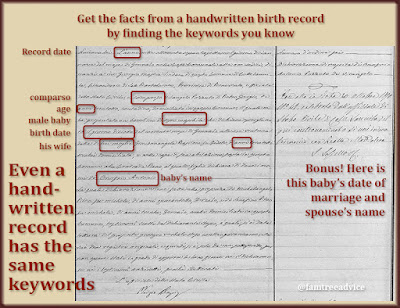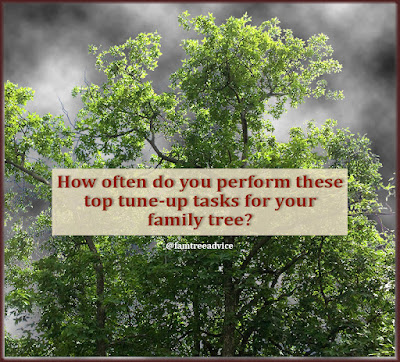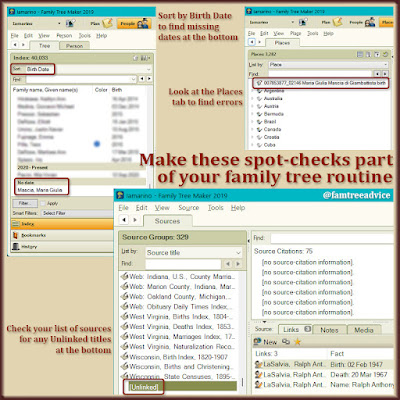Someone sends you a birth record for your ancestor. You can hardly wait to open it! And then it hits you. It's written in a foreign language.
Don't ever say "I can't read this language." You don't have to read the whole document. You have to pick out names and learn to decipher numbers written in longhand. You can do this!
Most birth records tell you several basic facts. The rest is formal boilerplate language. Do you care who the mayor was on that date? Or do you want to know the name and birth date of the baby and the parents' names and ages?
Here are the must-have genealogical facts on an old Italian birth record:
- Date. The document begins with the date a father declares his baby's birth. The baby may have been born days earlier. I'll show you how to find that date.
- Town and Province. These may be different than they are today.
- Father's Facts. The key facts are the father's name, age, occupation, and address.
- Mother's Facts. You'll find the mother's name, and it is her "maiden" name. Italian women keep their father's last name for life. You may or may not find her age and occupation.
- Baby's Facts. You'll find the baby's full name, date, and hour of birth. You may also see the baptism date.
The "boilerplate" I mentioned above has non-critical facts:
- The name of the sindaco (mayor) or other official.
- Two male witnesses. Sometimes these men are relatives, so look for words like zio (uncle) or avo (grandfather).
- Signatures or crosses. The father and witnesses must sign the record, but if they're illiterate, they'll make a cross. The clerk will write their names next to their marks.
- The mayor's signature.
Let's dissect a few different types of Italian birth records so you know exactly where to look.
Example 1: A Short Birth Record
 |
| You don't have to know another language. You simply have to recognize a few keywords. |
This 1812 birth record has very few pre-printed words on the page. The printed words help you find the handwritten facts you need.
#1 Get the Date and Town
The first line tells you the date the father declares the birth of the baby. It says:
L'anno milleottocento dodici a due del mesi di Gennaio
The year 1812 on the 2nd day of the month of January
All you need to know:
- anno = year
- mille = 1,000, ottocento = 800, dodici = 12, so 1812
- due = 2
- mesi = month
- Gennaio = January
Bookmark this outstanding list of Italian genealogy words, including all-important numbers and months. https://www.familysearch.org/en/wiki/Italian_Genealogical_Word_List
After the name of the sindaco (mayor), look for the words comune (town) and provincia (province). On this record we see names that changed over time. The town of Colle later became Colle Sannita. Its province was Molise, but now it's Benevento.
#2 Find the Father
Next, look for the printed word comparso (appeared). It's followed by the name of the person presenting the baby. It's usually the father, but it may be the levatrice (midwife) or avo/ava (grandparent).
In this case, it says comparso Giovanni Zeolla (the baby's father), di anni quaranta (40 years, or age 40), di professione contadino (profession farmer).
Next is the word domiciliato (domiciled or living in). Giovanni lives in questo comune (this town), followed by the street name (Strada li Tufi).
#3 Find the Date and Time of Birth
The next pre-printed words say, ed ha dichiarato (and he declares). What follows is the gist of what Giovanni has to declare: "on this date, at this time, a baby was born."
Here it says oggi (today) ad ore tredici (at the 13th hour, or 1 p.m.), a baby was born in Giovanni's home.
#4 Find the Mother
After the time and place of birth, we see who the baby was born to. It says: born to Maria Isabella Palmiero, sua moglie legittima (his legitimate wife), d'anni trenta (age 30), una femmina (female baby) che ci ha presentato (that he presents to us).
All that matters is: the mother of the baby girl is Maria Isabella Palmiero, age 30, Giovanni Zeolla's wife.
#5 Find the Baby's Name
No matter now many words may follow, find nome (name). This record says they give the baby the name Maria Vincenza.
Finally we have 2 witnesses (names, ages, occupations, addresses) and signatures or crosses.
To sum up:
- find the date
- get the father's facts
- see when and where the baby was born
- get the mother's facts
- find the baby's name
I hope you've noticed that some words are very similar to their English equivalents. You could have guessed what professione, legittima, femmina, and presentato mean, right?
Example 2: A Longer Pre-Printed Form
 |
| Some birth records are more verbose. Find those keywords to get to the good parts. |
This 1837 birth record contains a right column that tells you where and when they baptized the baby.
The left column contains a lot more pre-printed words than our first example, but it's the same drill.
- It begins with a date (1837, 1st of January)
- After the word comparso comes the father: Francesco Saverio Pilla, a contadino (farmer) who lives in this town
- He presents a female baby who was born to Brigida Verzino, his wife, age 23
- The father's age comes in the next sentence. After the word dichiarante (declarant) we find his age: anni ventitre (23 years)
- The baby was born nel giorno primo (on the first day) del mesi di Gennaio (of the month of January) anno corrente (this year) alle ore dieci (at 10 a.m.)
- The baby was born nella casa di propria abitazione (in the father's home) at Strada li Tufi
- They name the baby Anna Maria Filomena
The baptism column of this type of record can be tricky. The format is, "On date #1 the parish states that on date #2 we recorded the fact that we baptized this baby on date #3." Yikes, right?
With this format, the date closest to the baby's name is the baptism date. If you see 3 different dates, remember, they can't record the baptism before they perform it.
Example 3: A Completely Handwritten Birth Record
 |
| A completely handwritten foreign-language birth record? You know the drill! |
This type of document may have seemed overwhelming before. But now you know how to pick out the facts you need.
Once again, this document begins with a date (1867, 19th of January). Find the word comparso, and there's the father, Vitangelo Pozzuto. I love this type of document because it names the baby's 2 grandfathers. It says Vitangelo Pozzuto di Pietro Giorgio. That means Vitangelo's father is Pietro Giorgio Pozzuto. We also know Pietro Giorgio is still alive (the word di tells us that).
Look for anni (years) to find the father's age and occupation. In this case we see anni trentotto (38 years old), contadino. Now look for words to tell you when the baby was born and its sex. Here we see the bambino di sesso maschile (male baby) was born on il giorno diciotto (the 18th day) at ore ventuno (the 21st hour, or 9 p.m.).
Now look for the mother's name. You may see the words lui moglie (his wife) before her name. Here we see Giovannangela Basilone fu Fedele. The word fu (as opposed to the word di) is very important. It tells us that Giovannangela's father Fedele Basilone is already dead. I would record his death date as Bef. 18 Jan 1867. Giovannangela is 38 years old and lives in the town at Contrada Piano. (A contrada is a neighborhood.)
Finally, look for nome (or nomi, in this case) to find the baby's name: Onofrio Antonio.
I chose this record because it has a priceless bonus in the column. On 20 October 1890 in the same town, Onofrio Antonio Pozzuto married (find the word matrimonio) Maddalena Zeolla. If you find Maddalena's birth record, it should have the same note. This confirms you've connected the right people—even if there is no marriage record.
I hope you see that you don't need to be able to read every word on a foreign-language birth record. All you need to find are some keywords (comparso, anni, moglie, femmina/maschile, nome) and proper names. And keep FamilySearch's Italian genealogy word list handy!
Focus on the keywords, and the handwriting itself will be the only thing to slow you down. Then, all you need to get over that hurdle is practice. Or as they say in Philadelphia, "We're talkin' practice!"
And speaking of foreign-language records:





